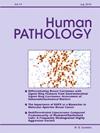食管基底样鳞状细胞癌与常规食管鳞状细胞癌免疫微环境特征差异的研究
IF 2.7
2区 医学
Q2 PATHOLOGY
引用次数: 0
摘要
目的:食管基底样鳞状细胞癌(basaloid ESCC)是一种罕见的食管鳞状细胞癌(ESCC)。我们描述了基底细胞样ESCC的肿瘤免疫微环境特征,并与常规ESCC进行了比较。方法与结果:队列1纳入104例基底细胞样ESCC患者和55例常规ESCC患者。104例玄武岩类ESCC中,纯玄武岩类ESCC 81例,混合玄武岩类ESCC与侵袭性玄武岩类ESCC成分及ESCC成分23例。在纯基底样ESCC中,未成熟的结缔组织增生反应(P+ TILs)较多(P=0.047),瘤内CD20+ TILs数量较多(P=0.047)。结论:我们的数据表明,与常规ESCC相比,基底样ESCC从免疫治疗中获益较少,表现为免疫“冷”,伴有未成熟型结缔组织增生反应、较低的TILs、较低的瘤周TLSs和较低的PD-L1表达。本文章由计算机程序翻译,如有差异,请以英文原文为准。

Unravelling the difference of immune microenvironment characteristics between esophageal basaloid squamous cell carcinoma and conventional esophageal squamous cell carcinoma
Objectives
Esophageal basaloid squamous cell carcinoma (basaloid ESCC) is an uncommon variant of esophageal squamous cell carcinoma (ESCC). We characterized the tumor immune microenvironment features of basaloid ESCC, and compared them with conventional ESCC.
Methods and results
One hundred and four basaloid ESCC patients and 55 conventional ESCC patients were included in Cohort 1. Among 104 basaloid ESCC, 81 were pure basaloid ESCC, and 23 were mixed basaloid ESCC with invasive basaloid ESCC components and ESCC components. In pure basaloid ESCC, there were more immature desmoplastic reaction (P < 0.001), fewer peritumoral tertiary lymphoid structures (TLSs) (P < 0.001), and lower tumor proportional score (TPS) and combined positive score (CPS) (P < 0.001 and P = 0.004) than in conventional ESCC. In mixed basaloid ESCC, the number of mature or intermediate desmoplastic reaction (P < 0.001), the tumor-infiltrating lymphocytes (TILs) score (P = 0.043), the proportion of stromal CD8+ TILs (P = 0.047), the number of intratumoral CD20+ TILs (P < 0.001), the number of peritumoral TLSs (P = 0.001), the number of peritumoral matureTLSs (P = 0.021), and the PD-L1 (22C3) CPS (P = 0.016) were lower in the basaloid ESCC components than in the conventional ESCC components. In addition, the data of 141 ESCC patients with neoadjuvant chemoimmunotherapy (nICT) were collected to compare immunotherapeutic outcomes. Among 141 nICT-treated patients, 115 patients had residual tumor cells remaining, including 101 with conventional ESCC and 11 with basaloid ESCC. In basaloid ESCC, 18.2% patients had less than 10% residual viable tumor in the esophageal wall (effective response), which was lower than 58.6% in conventional ESCC (P = 0.025).
Conclusions
Our data indicated that basaloid ESCC had less benefits from immunotherapy than conventional ESCC, and manifested as immune “cold” with immature-type desmoplastic reaction, lower TILs, lower peritumoral TLSs, and lower PD-L1 expression than conventional ESCC.
求助全文
通过发布文献求助,成功后即可免费获取论文全文。
去求助
来源期刊

Human pathology
医学-病理学
CiteScore
5.30
自引率
6.10%
发文量
206
审稿时长
21 days
期刊介绍:
Human Pathology is designed to bring information of clinicopathologic significance to human disease to the laboratory and clinical physician. It presents information drawn from morphologic and clinical laboratory studies with direct relevance to the understanding of human diseases. Papers published concern morphologic and clinicopathologic observations, reviews of diseases, analyses of problems in pathology, significant collections of case material and advances in concepts or techniques of value in the analysis and diagnosis of disease. Theoretical and experimental pathology and molecular biology pertinent to human disease are included. This critical journal is well illustrated with exceptional reproductions of photomicrographs and microscopic anatomy.
 求助内容:
求助内容: 应助结果提醒方式:
应助结果提醒方式:


